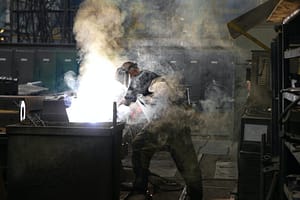A day in the life of… an occupational hygienist
What is occupational hygiene? What does an occupational hygienist do? Let’s take a look at the daily life of Mary Cameron, an occupational hygienist for EEUK Group.
Mary says:
Occupational hygiene is focused on worker health protection. An occupational hygienist is a professional who aims to maintain occupational wellbeing and control workplace hazards that can cause adverse health effects to the worker.
Let’s start the day at the beginning and say I have been assigned a job to undertake an assessment of airborne hazardous substances exposure. An occupational hygienist will normally rise quite early. The job will be at a client’s site and the site could be located anywhere in the UK. In the days before I would have spent time ensuring that my paperwork was in order and my sampling kit and media was at the ready. I then hop into the car and get to site bright and early. Once on site, the typical site induction, RAMS review, dynamic risk assessment, etc. will be completed.
The sampling scope would normally have been discussed and settled beforehand. Although this can sometimes need adjusting after the initial site walkthrough. Adjusting for conditions on the day and when reviewing the spread of work activities throughout site. Next comes the sample pump calibrations. The sampling media is fitted to the sampling train and the flow rate is calibrated to the appropriate level. These sampling trains are then placed onto each selected worker, with the sample head positioned within their breathing zone.
The worker then goes about their day, undertaking their usual activities. Next comes the most important part of the site visit; observations. The occupational hygienist is there to advise the client on how to protect of the health of their workers and to aid the client’s process-based risk assessments. The sampling results will provide helpful information. But we will also need to observe the workers and how they interact with the process. A hygienists’ best tools are their eyes and ears. Good people skills are also essential as we will need to question the site manager and the workers about the hazards present and how these hazards are being controlled. It’s not all serious though. The managers and workers are often very friendly and obliging!
The occupational hygienist will typically also apply qualitative tools to aid their investigation. Such as a Tyndall beam (dust lamp) to highlight fine particles which cannot be seen with the naked eye. Or a smoke generator to helps visual the air flow around a process and how this is being extracted into a local exhaust ventilation system which may be fitted to the process. This information gathering, observational analysis, and sampling data are all crucial in helping the occupational hygienist come to a sound conclusion regarding how well the workers are currently being protected against work-related ill-health and what improvements to these controls, or additional controls, should be put in place.
Occupational hygiene is a highly satisfying job. Our advice and recommendations to the client can be the difference between a healthy worker and a worker suffering with an occupational illness. We are workplace health protectors. Everyone deserves to go home healthy. And on top of this, we get to see a huge range of different industries. Anything from bakeries to foundries to car manufacturing. These processes are all fascinating. And these processes all come with hazards. Airborne chemicals, noise, vibration, thermal stress, EMF, biological agents, etc. The better we understand these hazards and how to control them the better we are at protecting the worker’s health. A career in occupational hygiene often becomes a career choice for life!
We’re currently hiring occupational hygienists – go to https://eeukltd.com/occupational-hygiene-consultant/ to find out more.
